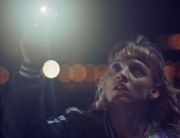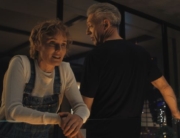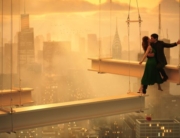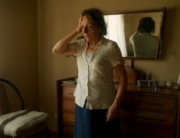As usual, Wes Anderson’s new film is sumptuous to look at and an amazing feat of artistry by his team of costumers, set decorators, and miniature model makers—and it was shot on Kodak 35mm film by cinematographer Robert Yeoman. Despite its beauty, the 1955 southwestern world of the titular desert town is unnervingly tidy. The color palate is mint green, salmon, teal, and bisque. Throughout, lackadaisical 1950s country tunes play at low volume on tinny outdoor speakers. Blindingly bright blue skies and little diners and motels with martini vending machines all look like hand-painted magazine ads of the era. Even the mushroom cloud bombs in the distance look painterly rather than menacing.
In stark contrast, the movie includes a framing device filmed as a black-and-white Playhouse 90–type TV show. Hosted by Bryan Cranston (harnessing Anderson’s signature flat, unhesitant line readings), the program takes a behind-the-scenes look at a staged production of the desert story. There are sight gags aplenty in the disarray of props, with talky asides from the play’s creators, including its gay author Conrad Earp (Edward Norton) and director Schubert Green (Adrien Brody).
Within all this window dressing emerges a scant plot: A group of five American kids, Junior Stargazers, are being honored in the sleepy desert town for their scientific inventions. Augie Steenbeck (Jason Schwartzman), the father of one of the kids, Woodrow (Jake Ryan, so hysterical in Eighth Grade, a bit under-utilized here), has accompanied his son, but he has yet to break the news of his wife’s recent passing to Woodrow and his siblings. (Her ashes rest, fittingly, in a turquoise Tupperware container.) Also arriving is Augie’s gruff father-in-law, played by a white-haired Tom Hanks. The two of them don’t get along, displayed by their constant banter, in which they often say the same dialogue in different ways. Meanwhile, Augie soon becomes smitten with another Stargazer parent, Scarlett Johansson’s Midge Campbell, a famed method actress.
Johansson is the true standout. She is the movie star character after all, but she seems to be wrestling with something more complicated than what’s on the surface. Akin to the film’s sense of artifice, Midge takes off her sunglasses to reveal a seeming bruise under her eye—just some “grease paint,” she notes, to get close to a character she’s playing. Depending on the day, she is fashioned like a Hitchcock blonde (Kim Novak) or brunette (Suzanne Pleshette, who shares Johansson’s smoky voice). The exchanges out of motel windows between Augie and Midge are the most amusing and complex here, tinged with underlying romantic possibilities.
Even though there is a bevy of notable actors in the cast, few make a lasting impression. The characters are thinly written, the comic flourishes often land with meteoritic thuds (such as Hanks emphatically shaking his fists), the emotional journey of Augie feels muddled, and the framing device comes across as superfluous. But there is something deeply sad and existential underlining Anderson’s movie, but it fails to connect its images and narratives underneath its relentless archness.
Though the focus is often on men, who seem to prattle on incessantly, the women end up tapping into this comic-tinged sorrow most arrestingly. Besides Johansson, Maya Hawke, with her eccentric vocal inflections, is acutely beguiling in a small role as a befuddled schoolteacher, as is the loopy brilliance of Tilda Swinton’s astronomer Dr. Hickenlooper. Margot Robbie plays an actress, dressed in Queen Elizabeth I garb (a knowing nod to one of Robbie’s roles), in the framing story, who also plays Augie’s wife in a scene from the play that was cut. Robbie has a brief monologue during which, despite all these layers of guile, you feel like you are watching a human being with feelings.
In different ways , both Jeffrey Wright, as former WWII General Grif Gibson, and Schwartzman, as a haunted war photographer, are scions of battle who are reaching for progress in this western expanse: Wright as a commander and Augie as an observer. “If you wanted to live a nice peaceful life, you picked the wrong time to be born,” Grif tells the precocious Stargazers. Thus, Anderson encapsulates an array of uneasiness and anxieties (quarantines, nuclear devastation) in a purposefully affected film set against a backdrop of real and unfounded concerns.
Ultimately one of the movie’s main idioms, The Invasion of the Body Snatchers–inspired “You can’t wake up if you don’t fall asleep,” is expressed in a flat intonation by the cast. Like many political mantras, it is straightforward but also perplexing, perhaps meaningless—is it emphasizing the importance of dreaming like wide-eyed kid astronomers? Is it somehow, especially in the specificity of this language, invoking ideas of activism today? Appealingly, Asteroid City discovers ideas on its own despite its tiring, overly schematic design.







Leave A Comment